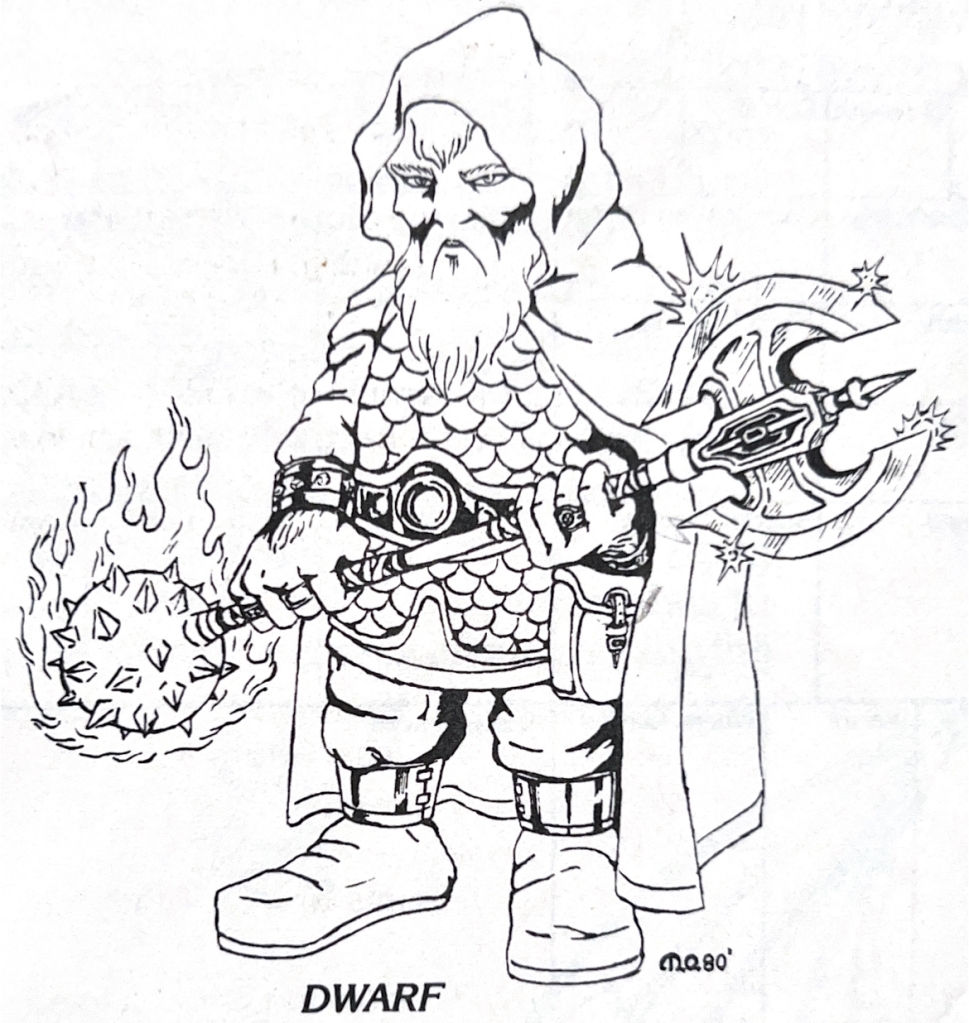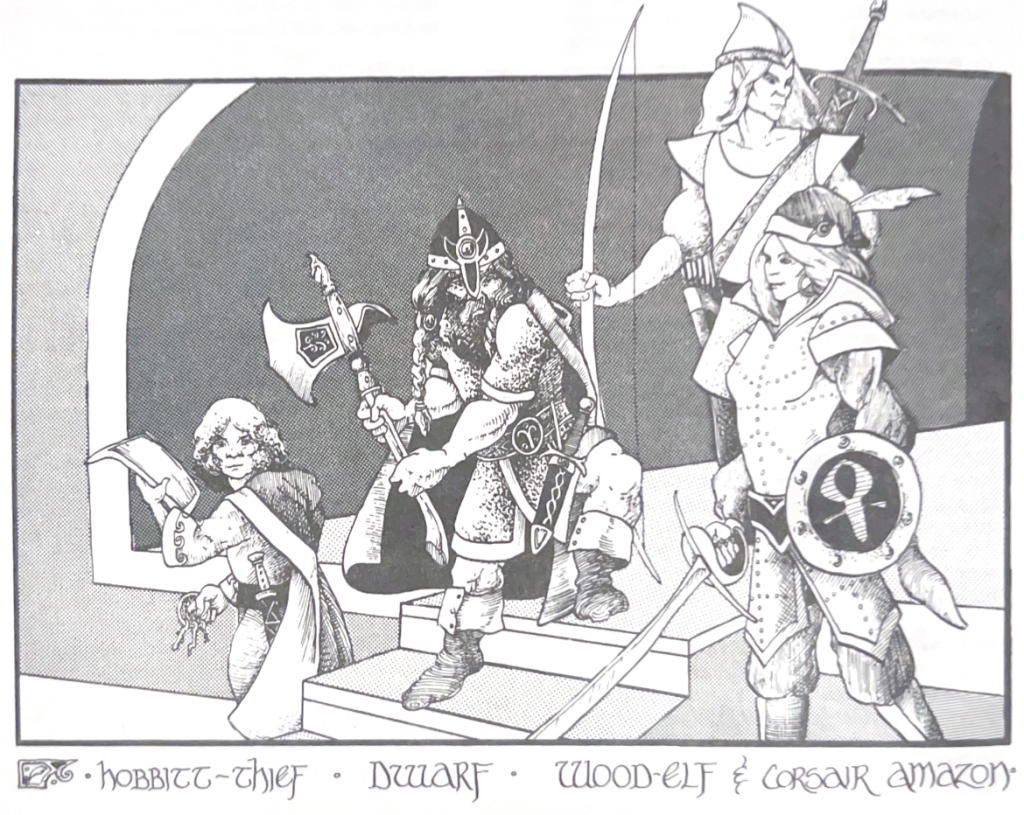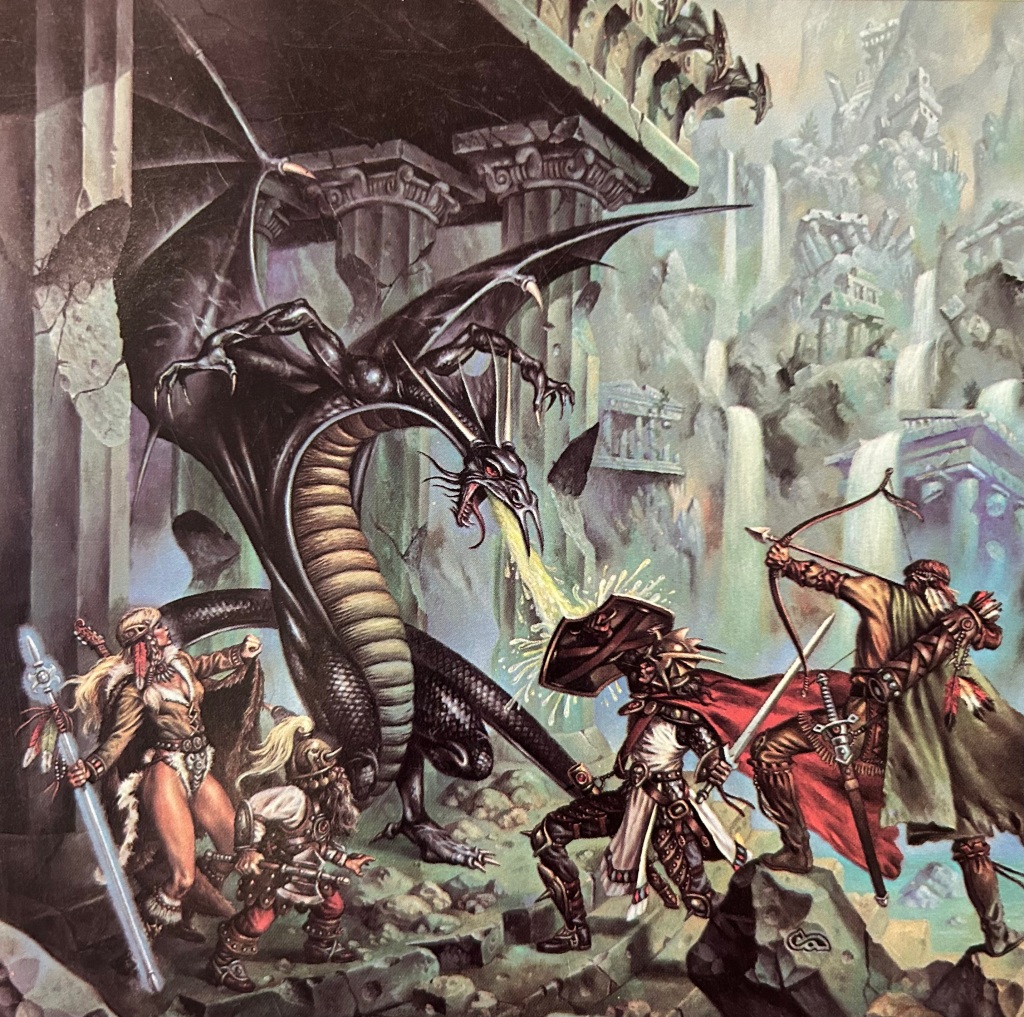Thieves don’t fight because they have better things to do
February 14, 2024
Last week, dwarves and elves. This week, The Arduin Adventure rulebook, on thieves:
Page 10:
“He accompanies adventurers to earn fame and loot and is the one who opens locked treasure chests, doors, and other enclosures. He almost never steals from his adventuring companions, and will fight only if it is desperately necessary.”
Page 11:
“THIEVES add one point each to their agility and dexterity. They also have a 30% chance of hiding in darkness and shadows.”
That’s it for thief skill mechanics in the book: hiding. Minimal, compared to any official version of D&D. It’s works as a baseline thief class that focuses on sneakiness. A skill applicable to a variety of adventure situations. Locks are mentioned, but no rules provided.
Sneaky, rarely fights, and doesn’t steal from the party? Sounds like a famous burglar: Bilbo Baggins…

The baseline 30% chance of successful hiding at 1st level is notable. Thieves in early D&D editions need to gain a couple levels to approach that skill chance. Some editions have race or stat bonuses to help close the gap, but typically 1st level D&D thief skills have such low chance of success that it disincentivizes usage. (An old post with a proposed solution) 30% seems about right for 1st level. That’s a 15+ on a d20.
Thus, in addition to hiding and sneaking, we use the 30% baseline chance for all thief skills, such as lockpicking and trap disarming. Want more? Preceding The Arduin Adventure, the original Arduin Grimoire trilogy elaborated on the gamut of thief abilities, including bonuses for demihumans and ability stats. With good stats, a 1st level demihuman thief can push a skill chance beyond 50%.
Treasure chests are a classic adventure element and I never tire of seeing them sprinkled throughout dungeons. We had success with them in DL8 Dragons of War. The Arduin Dungeon modules have chests all over the place, in many shapes and sizes. Usually locked and trapped. Lockpicking ought to be preferred over smashing or prying open a treasure chest. Raise the dungeon alert level (and chance of ambush) when the party is being noisy and leaving a trail of smashed chests and doors. It’s better to bring a thief.

Back to The Arduin Adventure page 10…a thief “will fight only if it is desperately necessary.”
So they do nothing during combat? What about the glorious backstab?
No. They have better things to do…
Sneak around for loot and secrets. Maybe bring that wimpy mage to help decipher weird runes.
Climb that idol and pry out its ruby eyes.
Disarm and unlock that treasure chest.
The party doesn’t need to kill every hoard guardian. Just have the warriors keep them busy long enough (maybe some parrying involved) for the thief to grab the treasure. Then everybody skedaddles.
If melee is raging and the thief discovers that the chest cannot be disarmed or unlocked, the party can consider withdrawing from battle.
Or decoy the monster to smash the treasure chest open for you, springing that nasty trap right in the beast’s face.
Or get a 2-for-1 deal by luring foes near the chest, then the wizard flings a Fireball, blasting the chest open and frying the monsters. That may damage the prize inside, but sometimes sacrifices must be made.
Tie trip wires along escape routes. Let the rest of the party know this is being done, of course. Maybe create a diversion out in the hall.
And so on. There’s much for thieves to do while the rest of the party is clashing with the enemy. Burglars gotta burgle.

Dwarves Grab Stuff and Elves Don’t Lie
February 9, 2024
Lately I’ve been preparing to resume our Arduin campaign originally started last summer. Trying to stick with the Arduin Adventure rulebook only, but dipping into the cornucopia of the Arduin Grimoire trilogy where Arduin Adventure is lacking. Sometimes making house rules, you know the drill.
One of the features I like in Arduin Adventure is how setting details are baked into the PC race descriptions and mechanics. For example, dwarf and elf PCs receive a bonus of +12 to select ability scores. No other PC race gets a larger bonus than that. Here’s the catch: roleplaying limitations…
Page 8:
“[Elves] never lie and will always repay a debt even if it takes a thousand years.”
Page 9:
“[Dwarves] love gold and precious things avidly, and each Dwarf has a 20% chance of simply grabbing any valuable without thinking.”
I love these. Rather than strictly limitations, I view them as fun and challenging roleplaying cues. As a player, try to minimize the drawbacks and use them cleverly for benefit. As DM, use them to spur action and introduce complications.

So sometimes dwarves grab valuables uncontrollably. Ok, seems like trouble waiting to happen. Notably, the trait doesn’t flat out prevent the dwarf from putting the valuable back where it was found, reluctantly, after the thrill of possession. Perhaps at the urging of friends. Perhaps at the convincing threats of the previous owner. The dwarf may try to avoid situations where the chance would present too much risk. For example, when a potentially cursed item is nearby. At other times, the dwarf may seek out situations to use the trait to their advantage.
In a world where dwarves are known for this behavior, they will be watched carefully. That could make dwarves good decoys. Sometimes a dwarf may not be compelled, but will intentionally grab a treasure, just to see what happens. And then play dumb. If they get caught: “So sorry about that…you know how dwarves are…all is forgiven?”

So elves never lie. That doesn’t mean they always tell the whole, plain truth. Sometimes they’ll say nothing at all. This can make an elf seem aloof, mysterious, evasive. Elves can use this trait to their advantage. Silence can be used deceptively.
Perhaps they tend to talk in riddle, metaphor, or allegory to obfuscate the truth or have multiple meanings. In that case, it’s up to the listener to decide what the truth is, and that decision may reveal more about the listener.
It’s not the first time Hargrave emphasized the notion of deception in his game. In the original Arduin Grimoire trilogy:
- The PC alignment chart has a “Lie Factor” for each alignment combination.
- One of the percentile thief abilities is LIE, the ”chance of successfully talking your way out of any situation in which you have been caught stealing, etc.”
- The stat blocks of monsters have “% Liar”. Some have a percentage, some are “too stupid to”, some “never lie”, etc.
That last one is famously connected to the infamous typo in the original D&D monster list: “% in Liar” instead of “% in Lair”.
I’m with Hargrave on this one: it’s more useful to know how often a monster is a LIAR, than to know if it’s in a LAIR. It’s an individualized roleplaying seed and supplement to reaction rolls. It makes explicit that monster encounters can often involve talking…and deception.
DL1: Straight to the Lost City
February 7, 2024

DL1 Dragons of Despair is a fun module…once you get past several pages of read-aloud text and aimless stage-setting. One option is to skip directly to page 8: Council Hall of the Highseekers. Get right to a meaningful decision for the PCs…
What path will you take to the Lost City of Xak Tsaroth? An overland route through the forbidden Darkenwood and across enemy-infested plains? Or a boat path through a raging river canyon and along an unknown sea coast?
Another option is skip to page 13. Go straight to the jungle of the lost city. Fight your way through vines and swamp things and draconians on log bridges. Discover the sunken city ruins and the temple of a forgotten goddess, with ominous stairs leading down.
The point is to get to the strongest part of the module: the dungeon…a subterranean lost city with classic pulp adventure features and an engaging map. It’s not a large or particularly complex environment, but it took us four sessions to complete. There’s just a lot to do and ways to do it.
There are several elements that aren’t elaborated upon in the module but, in our game, they played a big part of the dungeon action. Modern modules often cover these topics more directly, but older modules like this tend to leave things unstated for DMs to work out on their own. In any case, it helps to be prepared…
Faction play with Gully Dwarves.
Allying with the “bad guy” draconians isn’t probable, but it’s not assumed that PCs will work with the gully dwarves for mutual benefit. The module doesn’t give advice to the DM for how that relationship may play out. The descriptions of gully dwarf behavior implies that it would be like allying with a cross between Ewoks and hamsters.

In our game, the party did align with the little guys. The PCs kicked draconian ass early and often, earning gully dwarf respect and confidence. In turn, they helped the party as guides, spies, elevator operators, guards, alarms, decoys, etc. Despite being something of a comic relief element, the gullies can be a critical and valuable part of the adventure.
Where to rest and reload?
Chances are the party will want to rest, heal, and refresh spells while down in the lost city. They’ll need a safe haven or hideout. Again, not something the module mentions at all, but there are at least a few options for this:
In the gully dwarf district. In our game, a couple PCs had been seriously injured by poisonous snakes. They befriended Gully King Highbulp, who then offered a protected room for the PCs to recover.
At the upside down inn. The PCs rested here one night on their initial descent after the gullies assured them it was safe, primarily to re-memorize and swap in new spells. It’s located on a sub-level at mid-elevation, somewhat out of the way to return to if needed.
Recharge the crystal staff at the goddess statue. The staff has great healing powers (and more), but needs to be recharged at the temple. This is at the surface of the lost city, which presents a minor challenge to get up there and back, safely and stealthily.
In our game, the PCs returned twice to recharge the staff. Usage of the chain elevator became a fun focal point of the adventure, and here the gully dwarves were of great help to the party. Eventually the PCs learned how to use the treasury teleports for a less hairy and harrowing journey up and down.

How do the Draconians respond?
Hopefully the PCs are tactful about killing the enemy. Sooner or later the garrison of draconians will discover their numbers are decreasing and do something about it.
In our game, the PCs WERE tactful and never let a draconian escape from battle. Thus, the surviving garrison was unaware of the party. Instead, they suspected the gully dwarves were behind the killings and responded by raiding Gully King Highbulp’s district.
This occurred while the PCs were up top, recharging the crystal staff. When they came back down, the place was crawling with draconian soldiers. The endgame had begun.
To scroll or not to scroll?
In the goddess temple near the dungeon entrance there’s an encounter that will likely result in the party acquiring a magic user scroll holding a 10th level Lightning Bolt spell. A nice weapon for a party of level 3-6 PCs.
Thing is…using the pre-made characters and by-the-book 1E AD&D rules, the party can’t read or use the scroll during the adventure. This Raistlin doesn’t have Read Magic in his spellbook! Probably an editorial oversight. In later modules of the Dragonlance series, Raistlin does have Read Magic.
In our game, we decided Raistlin could use the scroll. It made the sickly mage more useful and worth protecting. That lightning bolt ended up being the killing blow against the final boss dragon. Fried to a crisp by a little crackling fork of electricity.




